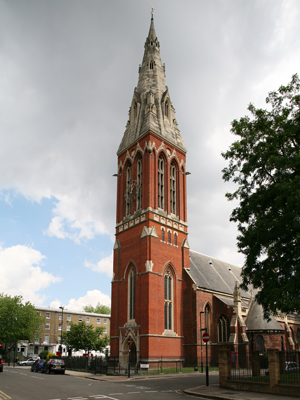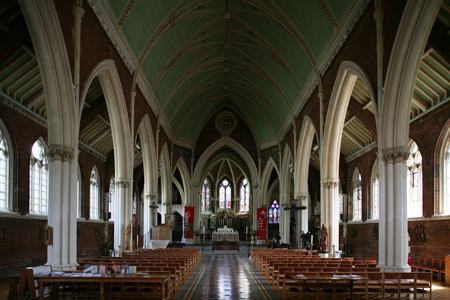| |
 |
 |
 |
| Comment on this report, or find other reports. |
 |
| Our Mystery Worshippers are volunteers who warm church pews for us around the world. If you'd like to become a Mystery Worshipper, start here. |
 |
| Find out how to reproduce this report in your church magazine or website. |
|
|
| 1974: St John the Divine, Kennington, London |
 |

Photo: Steve Cadman |
 |
Mystery Worshipper: Deputy Verger.
The church: St John the Divine, Kennington, London.
Denomination: Church of England.
The building: The church was consecrated in 1874, and it is a Victorian Gothic masterpiece in what was even at the time quite a poor part of London. Designed by George Edmund Street and completed by his son Arthur Edmund Street, the original interior decoration was by GF Bodley. Sadly the church was badly damaged in the Blitz, and while the drawings existed to recreate the exterior, much of the interior was changed. The spire, at 260 feet the tallest in south London, was restored in 1993 and dedicated to Queen Elizabeth II, who graciously allowed gargoyles to be created featuring herself and other members of the royal family, including her mother, the Prince of Wales, and Prince William.
The church: There are two church schools: a mixed primary and a school for older girls. The church is involved in the Robes Project, which provides night shelter for the homeless in this part of south London. The congregation includes enough members of diverse African communities to celebrate the independence days of (at least) Ghana, Nigeria and Sierra Leone, with fabulous lunches after the Sunday closest to the relevant date. After a lengthy interregnum, the new Welsh vicar has reinstated a cycle of daily eucharistic services in the inclusive Anglo-Catholic tradition, so the church offers an amazing mixture of bells, smells and accents under a Grade One listed roof.
The neighbourhood: It's really hard to define, especially if you don't know south London. The church calls itself St John the Divine Kennington, but it is more like North Brixton, although the postcode is Stockwell, and the parliamentary constituency is Vauxhall. It straddles a handful of neighbourhoods and draws its charm from that diversity. This is an extremely colourful part of London, just close enough to the Underground transport network to be almost central, but relatively affordable. Recent migrants from Portugal and West Africa mingle with the Caribbean community who have now been in the area for generations.
The cast: President: the Revd Mark Williams, vicar. Preacher: the Revd Prof Mark Chapman. Assistant Priest: the Revd David Garlick. These three were gloriously vested in gold-embroidered chasubles and attended by a deacon, a verger/warden, and a couple of acolytes. An impressive altar party. Plus a choir of 13, an appropriate number for the night in question.
The date & time: Maundy Thursday, 1 April 2010, 8.00pm.
What was the name of the service?
Mass and Liturgy of the Lord's Supper with the Watch until Midnight.
How full was the building?
There were a few dozen people. Not bad for a Thursday night, but by no means full. Plus the choir and altar party.
Did anyone welcome you personally?
Yes, there were a couple of friendly women at the back of the church dealing out orders of service.
Was your pew comfortable?
The church is furnished with rows of pale pink padded chairs, linked together in rows. This was an exceedingly long service and I was not uncomfortable at all.
How would you describe the pre-service
atmosphere?
Fairly quiet. There was stuff going on around the sanctuary and there were people arriving. The organist was playing Olivier Messiaen's Le Banquet Céleste. I was trying to discreetly find a pen that worked.
What were the exact opening words of the
service?
"In the name of the Father and of the Son and of the Holy Spirit. Amen." That came after the processional hymn, Praise to the Holiest in the Height.
What books did the congregation use during the
service?
The printed order of service contained all the hymns, and there was an extra sheet with two paintings, printed in colour. These featured later in the sermon, and carried on a thread the preacher had woven in his services throughout Holy Week, leading up to the climax on this night.
What musical instruments were played?
Organ.

Photo: Steve Cadman
Did anything distract you?
Well, being an Anglo-Catholic church in passiontide, the crosses were covered and the altar piece was closed. But the crucifix in the pulpit was uncovered, which was a bit odd. The star attraction of this church is the Kelham Rood, which is unusual in not being suspended above the sanctuary, but down at the level of mortals. The life-size bronze figures of St John and the Blessed Virgin Mary stand on the floor, and Christ on his cross is not unrealistically high off the ground. He was covered in a long red cloth. I was totally obsessed by that, to the point that I had to come back on Holy Saturday and see him uncovered.
Was the worship stiff-upper-lip, happy clappy, or
what?
It was impeccably choreographed, high church theatrical Holy Week, holy smoke, choral worship. There were so many dramatic moments, and they were all quite formal, but it wasn't stiffly done. This is a parish church in south London, not All Saints Margaret Street. And this was Maundy Thursday, when the congregation have parts of their own to play in the washing of feet and the vigil. So it was all very serious and reverent, as suits the occasion, but it was too passionate to be stiff or stuffy (at least to me). There was the ceremonial washing of feet, during which 12 people sat in a semicircle at the front with their backs to the congregation and had both feet washed by the vicar. There was the most evocative eucharist of the year, the Last Supper. There was the transfer of the blessed sacrament to the altar of repose, the dramatic stripping of the altars and the extinguishing of all candles. And finally there was the procession to the Garden of Gethsemane, the mournful singing, the charge to "wait with me one hour!" and the vigil.
Exactly how long was the sermon?
14 minutes.
On a scale of 1-10, how good was the preacher?
9 – One day I will give someone a 10, but the longer I don't the harder it gets. Mark Chapman was excellent: he spoke very quickly and packed a lot in. I would love to be one of his students. This was the last of his four Holy Week sermons, and blessed are those who got to them all.
In a nutshell, what was the sermon
about?
This was the culmination of a Holy Week series during which the preacher had used printed images of religious artworks as handouts to illustrate his sermons. For Maundy Thursday the theme was facing the cross, and the two images were The Master of the St Bartholomew Altarpiece, featuring the body of Jesus being taken down from the cross, with women weeping and skulls on the ground; and The Mass of St Gregory by Yesenbrandt. So it was about the physicality of the eucharist – the bread and wine are not just symbols, but real food and drink. Jesus offers his broken body and we receive it. The preacher talked about when in the 1950s and 1960s the priests started facing the people, instead of everyone in church facing the altar, facing east, how that meant that the priests turned their backs on the cross, and how occasionally in his own chapel (at Ripon College Cuddesdon) he still pushes it back and turns around, putting the blessed sacrament between himself and the cross. He said that at Easter we look east towards Jerusalem and the rising sun/son, and talked about the image of the broken body made whole. I can't do justice to it, as he spoke so fast and said so much.
Which part of the service was like being in
heaven?
The "passion" of it all. The heavenly choir, the heartbreaking music, the theatrics and splendour of the service. The intensity of the vigil, the desperate need to stay awake for an hour.
And which part was like being in... er... the other place?
Just a bit boring waiting for people to have their feet washed. My mind wandered and I got cross with myself for that, because of course it is a deeply spiritual time, and the choir kept singing throughout, so it wasn't really unpleasant. The problem was me, not them.
What happened when you hung around after the service looking lost?
The service ended with a silent vigil and people left quietly, one by one, including me.
How would you describe the after-service
coffee?
No, that wouldn't have happened at midnight, but I had to leave before the finish anyway. It was partly because the numbers were getting so thin at the vigil that I was feeling quite conspicuous, and partly because I didn't want to miss the last tube train and be stuck on a night bus in south London.
How would you feel about making this church your regular (where 10 = ecstatic, 0 = terminal)?
9 – It's seriously high up the candle, and I love that, but I would probably be unfaithful to it with something a little casual on the side occasionally.
Did the service make you feel glad to be a
Christian?
Oh yes. It stirred the imagination as to what it was like to be one of the very first Christians. Would I have behaved any better? It made me want to try.
What one thing will you remember about all this in seven days' time?
Well... I was so obsessed with the Kelham Rood that I had to go back and see it uncovered, and I will go back again. It is special, and not least because it stands in a working parish church in South London, rather than in one of the great cathedrals on the tourist trail. |
|
|
 |
 |
 |
| We rely on voluntary donations to stay online. If you're a regular visitor to Ship of Fools, please consider supporting us. |
 |
 |
 |
| The Mystery Pilgrim |
 |
| One of our most seasoned reporters makes the Camino pilgrimage to Santiago de Compostela in Spain. Read here. |
 |
 |
 |
| London churches |
 |
| Read reports from 70 London churches, visited by a small army of Mystery Worshippers on one single Sunday. Read here. |
| |
|
|
|
|


